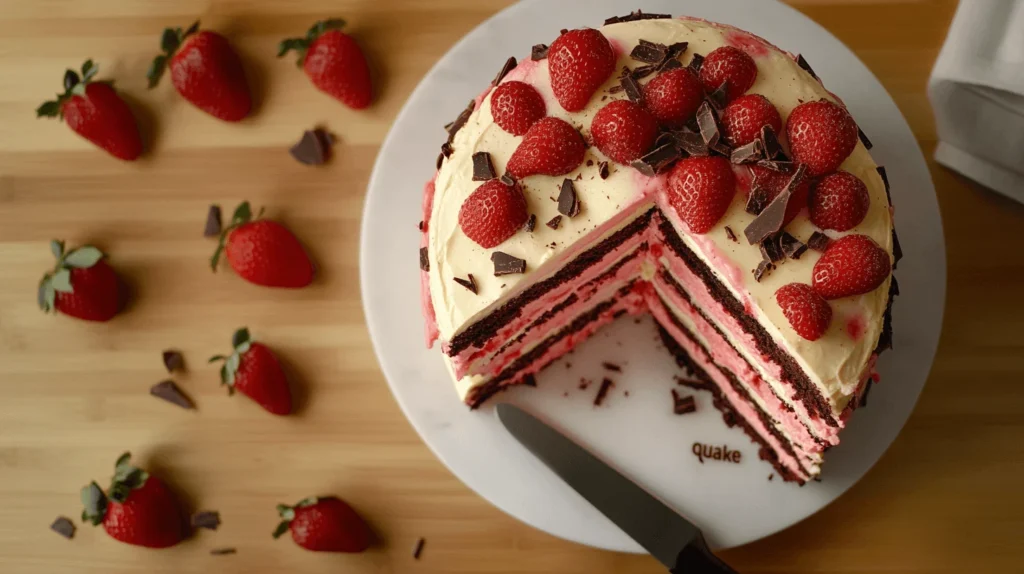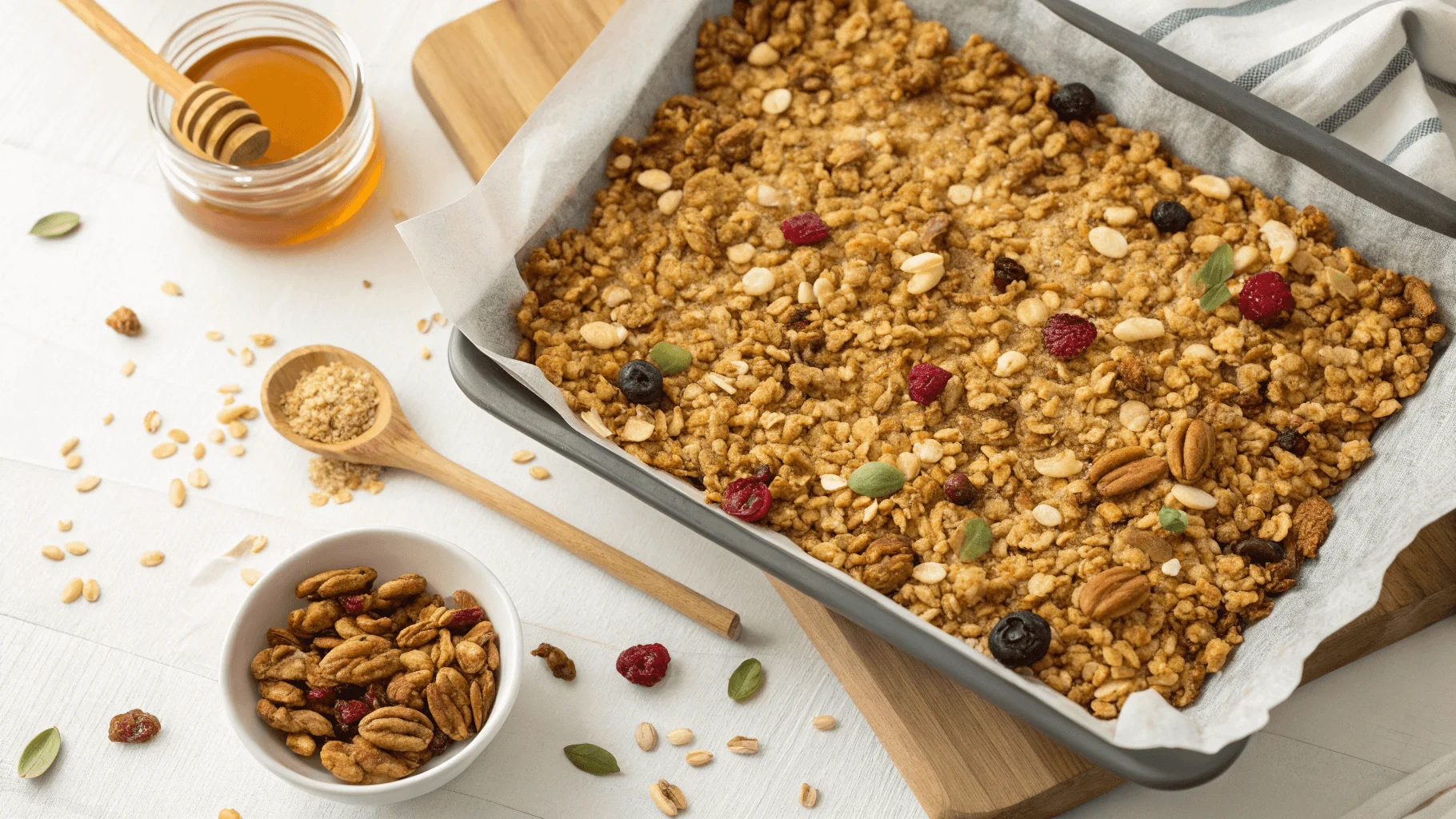Have you ever wondered what it would feel like to bite into a dessert that combines the excitement of an earthquake with the sweet, juicy allure of strawberries? Welcome to the world of the strawberry earthquake cake recipe —a decadent treat that’s as much about visual drama as it is about taste. This iconic dessert, which gained popularity through its unique “earthquake” effect, has become a favorite among bakers and dessert enthusiasts alike. Imagine a cake so vibrant and dynamic that it quakes and trembles when cut into, releasing layers of strawberry-infused cream and chocolate ganache in a mesmerizing cascade.
The origins of the strawberry earthquake cake recipe trace back to innovative pastry chefs who sought to push the boundaries of traditional baking. By incorporating elements of physics and structural engineering into their recipes, these culinary pioneers created a dessert that not only delights the palate but also captivates the eye. The “earthquake” effect is achieved by carefully constructing the cake with alternating layers of sponge, cream, and ganache, all encased in a sturdy outer shell. When sliced, the inner layers shift and sway, mimicking the movement of tectonic plates during an earthquake.
This article delves deep into the art and science of creating the perfect strawberry earthquake cake. We’ll explore the history and significance of this dessert, uncover its secrets, and provide step-by-step instructions for making your own at home. Whether you’re a seasoned baker or a curious beginner, this guide will equip you with everything you need to know to master this show-stopping creation. From selecting the right ingredients to troubleshooting common challenges, we’ll cover it all. So, let’s embark on this delicious journey together!
The strawberry earthquake cake is more than just a dessert—it’s an experience that combines the joy of baking with the thrill of presentation. By understanding its components, techniques, and variations, anyone can create a masterpiece that wows friends and family.
Understanding the Structure of a Strawberry Earthquake Cake

Mastering the Layers of a Strawberry Earthquake Cake
At the heart of every successful strawberry earthquake cake lies its intricate layering system. Each component plays a crucial role in achieving the desired texture, flavor, and, most importantly, the “quake” effect. To fully appreciate the complexity of this dessert, let’s break down its key layers:
The structure of a strawberry earthquake cake relies on three primary layers—sponge cake, strawberry cream filling, and chocolate ganache—that work together to create a visually stunning and delicious treat.
For tips on balancing flavors and textures in desserts, check out our article on Fiesta Lime Chicken Recipe, which offers insights that can be applied to both savory and sweet dishes.
The base of the cake is typically made from a light and airy sponge cake. This foundational layer provides stability while allowing room for the other components to move freely when sliced. For optimal results, use a vanilla sponge recipe enriched with butter and eggs to ensure both structure and moisture. Adding a hint of almond extract can enhance the flavor profile without overpowering the strawberries.
Next comes the star of the show: the strawberry cream filling. This luscious mixture consists of whipped cream infused with fresh strawberries or strawberry puree. The cream acts as the catalyst for the quake effect, as it moves and shifts when the cake is cut. To achieve the perfect consistency, whip the cream until stiff peaks form, then gently fold in the mashed strawberries. Avoid overmixing, as this could deflate the cream and compromise its ability to maintain its shape during assembly.
Finally, the outer shell is crafted using a rich chocolate ganache. This glossy coating serves dual purposes: it seals the cake, preventing the cream from leaking out, and enhances the visual appeal with its dark, velvety finish. For best results, heat heavy cream and pour it over high-quality dark chocolate, stirring until smooth. Allow the ganache to cool slightly before pouring it over the assembled cake, ensuring an even coat.
Achieving the Perfect Quake Effect
To maximize the quake effect, pay close attention to the proportions of each layer. Too much sponge cake can restrict movement, while insufficient cream may result in a lackluster performance. Aim for a ratio of approximately 1:2:1 (sponge:cream:ganache) to strike the right balance. Additionally, chill the cake thoroughly before serving to firm up the cream and prevent premature shifting.
For more ideas on creative flavor combinations, you might enjoy our Pickle Pie Pizza, a bold and colorful recipe that pushes the boundaries of traditional baking.
Tips for Assembling the Cake
Proper assembly is critical to the success of your strawberry earthquake cake. Begin by trimming the sponge cake to fit snugly within a springform pan or mold. Layer the strawberry cream evenly across the base, taking care not to press down too hard, which could compact the cream and reduce its mobility. Repeat this process until all layers are incorporated, finishing with a final layer of sponge cake on top. Once assembled, pour the cooled ganache over the cake and refrigerate for several hours to set.
For another innovative recipe that combines creativity and precision, take a look at our guide on ground beef pasta without tomato sauce, which showcases unique techniques for creating memorable dishes.
Explanation: Why These Layers Matter
Each layer contributes uniquely to the overall experience of the strawberry earthquake cake. The sponge provides support, the cream delivers movement and flavor, and the ganache adds elegance and protection. Together, they create a harmonious blend of textures and tastes that elevate this dessert beyond ordinary cakes.
With a solid understanding of the cake’s structure, let’s now examine some common challenges bakers face and how to overcome them.
Common Challenges and Solutions in Baking a Strawberry Earthquake Cake

Troubleshooting Your Strawberry Earthquake Cake
Even the most experienced bakers encounter obstacles when attempting to create a strawberry earthquake cake. From cracked ganache to overly dense sponge cakes, these issues can derail an otherwise promising project. However, armed with knowledge and problem-solving strategies, you can tackle these challenges head-on.
While baking a strawberry earthquake cake presents certain difficulties, identifying and addressing these issues early ensures a smoother process and better outcomes.
One of the most frequent complaints involves cracks forming in the chocolate ganache after refrigeration. This occurs when the ganache cools too quickly or lacks sufficient flexibility. To prevent cracking, opt for a higher fat content chocolate, such as couverture, and incorporate a small amount of corn syrup or glucose into the mixture. These additions increase elasticity, allowing the ganache to contract without breaking.
Another prevalent issue arises from the sponge cake becoming soggy due to excessive moisture from the cream filling. This happens when the cream isn’t adequately stabilized or if the cake isn’t chilled long enough before slicing. To combat this, stabilize the whipped cream by adding powdered sugar and a tablespoon of gelatin dissolved in water. Furthermore, ensure the cake remains refrigerated for at least four hours prior to serving, giving the cream ample time to set.
Addressing Overly Dense Sponge Cakes
A dense sponge cake can hinder the quake effect by restricting the movement of the cream layers. This density often stems from overmixing the batter or failing to properly incorporate air during mixing. To avoid this, mix the batter gently and only until the dry ingredients are fully incorporated. Using room-temperature eggs and butter also helps achieve a lighter texture.
Preventing Cream Leakage
Leaky cream is another common concern, especially if the ganache doesn’t seal the cake effectively. Ensure the ganache completely covers the sides and top of the cake, leaving no gaps for the cream to escape. Applying a thin crumb coat before adding the final layer of ganache can further reinforce the seal.
Why Expert Techniques Matter
While some might argue that shortcuts or simplified methods can yield similar results, adhering to proven techniques guarantees consistent quality and reliability. By investing time in mastering these skills, you lay the groundwork for creating exceptional desserts every time.
Now that we’ve addressed potential pitfalls, let’s explore creative ways to adapt and expand upon the classic strawberry earthquake cake concept.
Creative Variations and Applications of the Strawberry Earthquake Cake

Expanding the Horizons of Your Strawberry Earthquake Cake
Beyond its traditional form, the strawberry earthquake cake offers endless possibilities for customization and innovation. Whether you’re hosting a themed party or simply seeking inspiration for your next baking adventure, these variations promise to delight and inspire.
By experimenting with flavors, textures, and presentations, you can transform the classic strawberry earthquake cake into a personalized masterpiece tailored to any occasion.
Consider swapping strawberries for other fruits to introduce new dimensions of flavor. Raspberries, blueberries, or mangoes all pair beautifully with chocolate and cream, offering unique color contrasts and taste profiles. Alternatively, incorporate complementary spices such as cinnamon or cardamom to add depth and intrigue.
Themed Party Ideas Featuring Strawberry Earthquake Cakes
Imagine presenting a rainbow-themed earthquake cake at a child’s birthday party, where each layer features a different fruit and corresponding hue. Or, design a tropical twist for a summer gathering, substituting coconut cream for regular whipped cream and adding diced pineapple to the filling. These adaptations not only enhance visual appeal but also cater to diverse dietary preferences.
Future Trends in Earthquake Cakes
As trends in baking continue to evolve, expect to see more emphasis on sustainability and health-conscious options. Incorporating plant-based alternatives, such as almond milk and aquafaba, allows vegans and those with dairy sensitivities to enjoy this beloved dessert. Meanwhile, advancements in molecular gastronomy could lead to entirely new methods of achieving the quake effect, incorporating gels or foams instead of traditional cream.
In conclusion, the strawberry earthquake cake represents far more than just a dessert—it embodies creativity, passion, and the joy of sharing food with loved ones.
Conclusion
Summary
From its captivating layers to its thrilling quake effect, the strawberry earthquake cake stands as a testament to the artistry and science of baking. By understanding its structure, overcoming common challenges, and embracing creative variations, anyone can master this remarkable dessert. Remember, the key lies in balancing ingredients, paying attention to detail, and having fun throughout the process.
Final Thought
What does the future hold for the strawberry earthquake cake? Will emerging technologies redefine its construction, or will tradition prevail? One thing is certain: as long as people crave experiences that engage both senses and emotions, this dessert will remain a timeless favorite.
Future Outlook
Looking ahead, expect to see greater emphasis on personalization and inclusivity in earthquake cakes. Customizable flavors, allergen-free options, and eco-friendly packaging will likely become standard features, catering to modern consumers’ demands. Stay tuned for exciting developments in this ever-evolving field!
FAQs
Q: Can I freeze my strawberry earthquake cake?
A: Yes, but freezing may affect the quake effect. Wrap tightly in plastic wrap and store in an airtight container for up to two months.
Q: How do I transport the cake safely?
A: Use a sturdy box slightly larger than the cake, securing it with padding to prevent shifting during transit.
Q: What type of chocolate works best for the ganache?
A: High-quality dark chocolate with a cocoa content of 60-70% yields the richest flavor and smoothest texture.
Table of Contents
strawberry earthquake cake recipe
This show-stopping strawberry earthquake cake is a masterpiece of flavors and textures. With alternating layers of light sponge cake, creamy strawberry filling, and decadent chocolate ganache, it creates a mesmerizing “quake” effect when sliced. Perfect for celebrations, this dessert combines the sweetness of fresh strawberries with rich chocolate for an unforgettable experience that will impress any audience.
- Prep Time: 45 minutes
- Cook Time: 30 minutes
- Total Time: 1 hour 15 minutes
- Yield: One 8-inch layered cake
- Category: Dessert
- Cuisine: American
Ingredients
For the Sponge Cake:
- 2 cups all-purpose flour
- 1½ cups granulated sugar
- 4 large eggs, at room temperature
- ¾ cup milk, at room temperature
- ½ cup unsalted butter, melted
- 2 teaspoons vanilla extract
- 2 teaspoons baking powder
- A pinch of salt
For the Strawberry Cream Filling:
- 2 cups heavy whipping cream
- ¼ cup powdered sugar
- 1 teaspoon vanilla extract
- 1 cup fresh strawberries, mashed or pureed
For the Chocolate Ganache:
- 1 cup heavy cream
- 8 oz high-quality dark chocolate (60-70% cocoa), chopped
- 1 tablespoon corn syrup (optional, for added shine)
Optional Garnish:
- Fresh strawberries, sliced
- Chocolate shavings
Instructions
Step 1: Prepare the Sponge Cake
- Preheat your oven to 350°F (175°C). Grease and line two 8-inch round cake pans.
- In a mixing bowl, whisk together flour, sugar, baking powder, and salt.
- Add eggs, milk, melted butter, and vanilla extract. Beat on medium speed until smooth and well combined.
- Divide the batter evenly between the prepared pans and bake for 25-30 minutes, or until a toothpick inserted comes out clean. Let cool completely before assembling.
Step 2: Make the Strawberry Cream Filling
- In a large mixing bowl, whip the heavy cream, powdered sugar, and vanilla extract until stiff peaks form.
- Gently fold in the mashed strawberries, being careful not to deflate the cream. Set aside.
Step 3: Create the Chocolate Ganache
- Heat the heavy cream in a small saucepan over low heat until just simmering. Pour it over the chopped chocolate and let sit for 2-3 minutes. Stir until smooth and glossy. Add corn syrup if desired for extra shine. Allow the ganache to cool slightly but remain pourable.
Step 4: Assemble the Cake
- Trim the tops of the sponge cakes to ensure they are level. Place one layer on a serving plate or cake stand. Spread a thick layer of strawberry cream filling evenly over the top.
- Repeat with the second sponge cake layer and another layer of cream. Top with the final layer of sponge cake.
- Pour the cooled ganache over the entire cake, ensuring it covers all sides and drips down naturally. Use an offset spatula to smooth the surface if needed.
Step 5: Chill and Serve
- Refrigerate the cake for at least 4 hours to set the ganache and stabilize the cream. Slice carefully to reveal the stunning quake effect. Garnish with fresh strawberries and chocolate shavings before serving.
Notes
- For a dairy-free version, substitute heavy cream with coconut cream and use vegan chocolate for the ganache.
- To enhance the flavor, add a splash of almond extract to the sponge cake batter or incorporate lime zest into the strawberry cream.
- Store leftovers in the refrigerator for up to 3 days. Allow the cake to come to room temperature before serving for optimal taste and texture.
Nutrition
- Serving Size: 8-10 servings
- Calories: 450 kcal
- Sugar: 40g
- Fat: 25g
- Carbohydrates: 50g
- Protein: 6g






